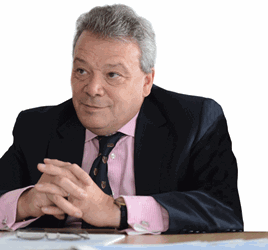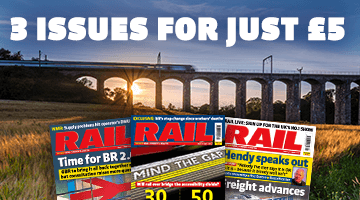“We might be the safest, but we’re not safe enough, and there are plenty of areas where we see a need for improvement. This is not about gold plating, this is about driving towards excellence,” he says.
And these areas are?
“Safety culture and management maturity,” Prosser answers without hesitation. “It is slowly improving - but only slowly - and it’s still some way short of excellent.”
So is the railway still lagging culturally behind the hazardous industry Prosser came from - the chemical industry - or other high-risk industries such as oil and gas?
“Yes, the railway is still behind,” he replies. “The rail industry is scoring maybe 3 out of 5. Some parts of it are better than that, such as London Underground, which is maybe three and a half. But other sectors are up at 4-plus, so rail has some work to do still.”
Why is the railway lagging behind those other industries - after all, the railway has been around longer, so might therefore be expected to be stronger?
“It takes time and consistency of message from senior management, and we have that now much more strongly with Mark Carne . I don’t think this consistency has been there all the time.”
So was railway management deficient in that respect before then? Or is this cultural deficiency down to a lack of investment in the past?
“No,” says Prosser. “I think it’s just getting the right leadership. It’s very much down to leadership, and then you have to trickle that leadership right down through the organisation. I’ve stressed this message endlessly to NR, who are now saying to me they realise that not all their managers and middle ranks and some of the senior ranks ‘get it’, as it were. To completely get this right and make it effective takes time, and it takes perseverance.”
But I’m still puzzled as to why rail, which has been around much longer than either the chemical industry, or oil and gas, isn’t streets ahead of those industries, as you logically might expect.
If it’s not a lack of investment, is it because the railway has (to put it bluntly) dragged its feet in bygone decades, making what can be often costly changes only when public, media and political pressure after a big accident demands change?
Prosser agrees: “I think you’ve hit the nail on the head there. We’ve been too reactive as an industry in the past. That’s why I’m getting back to this ‘predict and prevent’, rather than learn from your mistakes, which has been the way rail has approached this. It’s not a bad thing to learn from your mistakes - but it’s much better if you can learn before you have the big mistakes.
“You know from history that history doesn’t look good on the railways. This might sound controversial, but it’s nonetheless true - there is no such thing as the good old days in railway speak. The industry was always too reactive in implementing safety improvements, rather than being proactive.
“One of the things I’m also trying to
stress is that sometimes too much change
can cause the consistent improvement
message to be diluted - so consistency, consistency and leadership coming from the same people, driving the same message for a period of time, is very important.
“We went through a period after privatisation where we saw some quite serious accidents, around the time of the 1990s and 2000s, so that took us back. Sometimes it’s three steps forward and one step back, but I think we’re now in a period where we’ve had enough stability to pave the way for a final push to take us to excellence. We would see not just excellence in health and safety, but excellence in customer satisfaction and efficiency as well.”
History does support Prosser’s view that major advances in railway safety only followed major accidents, with consequent reputational damage for the railway, accompanied by Railway Inspectorate action and pressure. Look at history and this was certainly true of major safety advances such as ‘lock, block and brake’ - facing point locking/interlocking, block signalling to safely separate trains and continuous train brakes where every wheel can be braked, controlled by the driver.
If we accept this is true, then HMRI itself in the 1990s, when it was weakened as a result of it being part of the Health & Safety Executive, must surely bear part of the responsibility for creating the conditions that led to Southall (1997), Ladbroke Grove (1999), Hatfield (2000) and Potters Bar (2002)?
Prosser responds: “It’s very important that we have a strong and effective regulator, particularly when we have an industry that isn’t achieving the excellent level of management maturity that we really want. Therefore, the safety regulator has to be really on the ball.”
So that’s a yes then? HMRI must accept some responsibility for allowing the conditions where those accidents occurred to develop?
“I can only speak personally on this when those sorts of things happen, then the regulator has to take some of the blame. And that’s why it’s so important that we focus on continuous improvement of ourselves too, in this organisation.”
It says a lot about Prosser that he’s prepared to accept this point. And it certainly supports the comments made by Chief Inspector of Railways Alan Osborne, who resigned in October 2003 in protest at the damaging management of HMRI by HSE (as covered exclusively in RAIL at the time, RAIL 481).
Prosser moves onto other areas where he wants to see consistent action and improvement. For example, he reckons that the railway is way behind in occupational health management and development. He agrees that some of the more traditional managers might see this as a bit “soft and fluffy”, and in the past might have viewed it through a rather macho prism. Consistency and maturity of approach will resolve this issue, he says.
The railway’s incredible ongoing growth also has an inevitable impact on increasing risk. Put simply: the more trains you run, the more chance statistically there is of those trains (and those who use, drive and control them) running into trouble. The odds of trouble shorten as activity increases - the trick is to stop the averages catching up.
“Growth is a good thing, of course, but there are safety implications,” says Prosser. “Network Rail over the past ten years has increased its efficiency by 30%, but at the same time the number of passengers has grown by about 60%.
“So we must look forward and properly manage this growth, because if we lose sight of these basic things we could drop the ball. We need to understand the impact of growth on the infrastructure, and renew and enhance it in a safe and sustainable way. This means focusing on the real basics of keeping London Underground or Network Rail infrastructure - the day to day stuff that needs to be done to sustain and maintain the railway.”
Is Network Rail doing that?
“We’ve certainly had some issues in CP4, and we’ve taken enforcement action around some aspects of track geometry and twists. There have been issues with renewal plans and maintenance backlogs. NR didn’t meet all its renewal plans for CP4, so that’s why I’m saying we mustn’t lose sight of these things. We’re putting a lot of pressure on Network Rail to make sure its plans going forward are properly resourced - and we will enforce when necessary.
“It is very important not to lose sight of keeping the railway sustainable, because we’ve seen a lot of investment after the problems from the early 2000s. We also have to realise that there’s often too much of a tendency to look at global numbers about the state of the assets. We must understand that a very local issue can suddenly become a big problem.”
When I make passing mention that NR’s enhancement programme looks something of a shambles (I have Great Western/Midland Main Line electrification in mind), Prosser is keen to ensure balance.














Login to comment
Comments
No comments have been made yet.